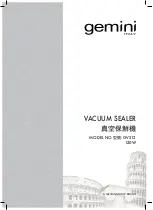
60
TIPS FOR BEST RESULTS
VACUUM SEALING AND FOOD SAFETY
Note
Vacuum sealing is
NO substitute for refrigeration or freezing
. Any perishable
foods that require refrigeration must still be refrigerated or frozen after vacuum
packaging. As with any other storage method, food must be checked carefully
before storage and, as well, before consumption.
WARNING:
Before placing evacuated containers in the freezer, check
whether your containers are suited for freezing (e.g. check for any appropriate
icons), because some types of plastics get brittle under freezing temperature con-
ditions. Especially when taking the container out of the freezer, these containers
could burst causing risk of injuries and damage according to splinters and splashes
being hurled about.
Note
Do not use the designated bottle stopper on plastic bottles. Do not attempt to eva-
cuate highly alcoholic, or carbonated, or sparkling beverages (e.g. lemonade,
sparkling wine, spirits).Vacuum packaging extends the shelf life of foods by remo-
ving most of the air from sealed bags and containers, and additionally preventing
air and germs from getting into the sealed packaging again. Additionally, vacu-
um packaging helps inhibiting the growth of a lot of microorganisms. However,
please keep in mind that yeast and some types of bacteria (e.g. the highly toxic
botulism causing bacterium) can grow even without air. Others produce spores
still viable after evacuation.
• In general, bags may be re-used, but do not re-use bags that had been filled with
any fatty and/or highly perishable foodstuffs (e.g. meat, sausages, cheese, fish,
or seafood). To prevent germs from entering your food, before filling, you should
rinse containers or re-used bags with hot water (at least up to 80°C). Check first,
whether the container or bag will tolerate the desired high temperature.
• Some types of food contain aromas and colours that infuse plastics and cau-
se persistent odours and discolouration (e.g. red cabbage, capsicum, garlic).
Before re-utilisation of bags and containers, you should check whether any
odours of the recently stored food persist within the bags or containers.
• For long-term storage, always freeze perishables that have been vacuum packa-
ged. Food packed in bags may be placed in the freezer without hesitation.
When
using vacuum containers, please keep in mind that some types of plastics
will get brittle under low temperature, thus bursting when under low pressure.
















































